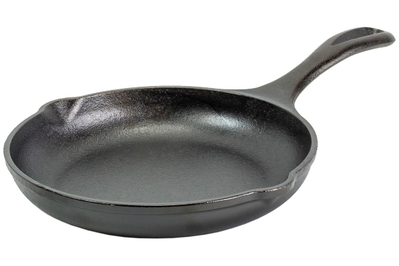Cast-iron pans have existed for hundreds of years, and scores of decades-old pans are still being used regularly. Carbon-steel pans are a more-recent cookware development, and they have grown more popular in the US in the past several years.
Top pick
Cast-iron and carbon-steel pans stay nonstick through a process called “seasoning,” in which layers of polymerized fat are baked onto the metal to create a slick cooking surface.
While a carbon-steel or cast-iron pan will never be as nonstick as a PTFE pan, you can get close. The key to using these pans effectively is knowing how to build and maintain that seasoning, as well as utilizing some best practices for cooking in them. (I outline some tips on that a little farther down.)
Both our top-pick carbon-steel pan and our favorite cast-iron pan come pre-seasoned, so new pans already have a relatively nonstick base from first use. But you need to continue to build that base over time—likely for around three to six months. You said you’ve been working on this, so that’s great!
In her testing, senior staff writer Lesley Stockton noted that frying onions in the pan helped to jump-start the polymerization needed to reinforce the pan’s seasoning. Similarly, senior editor Marilyn Ong uses a method recommended by cookbook author Grace Young for seasoning a carbon-steel wok: Stir-fry scallions in it for 20 to 30 minutes. I think this is worth trying as an easy way to build that slick coating.
With carbon-steel and cast-iron pans, cleaning should be done with a light touch. This is where we suspect you’re running into trouble. Generally, all you need is a small bit of soap and a gentle wipe, but the video above goes into more detail. Scrubbing too deeply can remove all of that wonderful nonstick seasoning you’ve built up, and this might be why you’re seeing reduced performance. Also, remember to dry your pan thoroughly.
To further maintain the seasoning, re-season the pan after every wash: Rub a tiny amount of whatever high-smoke-point oil isn’t being vilified at the moment (avocado?). Then heat until all of the oil is burned off and let the pan cool.
Cast-iron and carbon-steel pans are oven-safe. But note that it is not recommended to cook acidic foods in either of them, as the metal tends to be reactive, imparting an off-flavor to the food, though seasoning can help with that. “A well-used and well-seasoned pan could probably tolerate the occasional handful of chopped tomatoes or squeeze of lemon to make a pan sauce,” Lesley wrote in our guide to carbon steel pans. “But I’d feel comfortable doing that only after six months to a year of heavy use.”
The biggest difference between cast-iron and carbon-steel pans—aside from the materials they’re made from—is the weight. Our “lightweight” Lodge pick is 6½ pounds (versus 8½ pounds for the standard Lodge), while the 10” OXO carbon steel pan is a petite 2.75 pounds. A heavier cast-iron pan takes longer to heat up than a lighter-weight pan, but it will also hold more heat. Once it’s hot, it will stay hot, so it is great for tasks like searing steaks or deep-frying.
On the other hand, carbon steel is more responsive to temperature changes: It heats up faster, but it will also cool faster when you throw cool ingredients in a hot pan.





